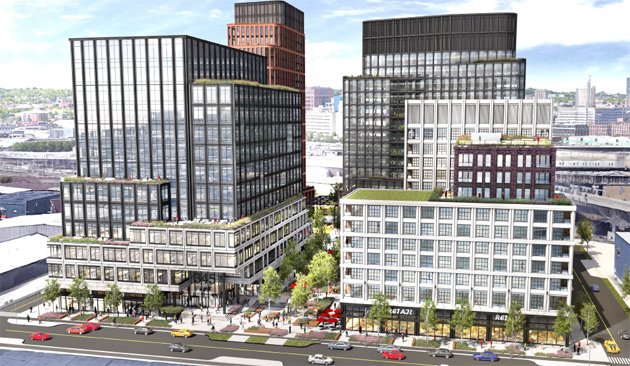Developer proposes complex on Dot. Ave. in South Boston that includes a 20-story residential building and, of course, life-sciences space

Rendeirng with work by Elkus Manfredi, ZGF and Cookfox.
National Development of Newton has filed plans to replace a Gold's Gym and a series of Marr Rigging warehouses at 323-365 Dorchester Ave. with four buildings - two with residential units and two outfitted to support the life-sciences labs and offices that are the current hotness in Boston development.
In the plans, filed with the BPDA, the developer says it would build 345 residential units in two buildings on the 5.4-acre site - one 20 stories, one 11 - and 358,550 square feet of dedicated lab space and 285,550 square feet of offices for all those lab workers.
How a high-flying bird would see the other side of the complex:

Also proposed: 55,150 square feet of ground-floor space for restaurants, a grocery and other retail space, along with 670 parking spaces in a below-ground garage and a total of 542 spaces for bicycles.
National Development says it deliberately hired numerous different architectural and engineering teams to come up with a 21st-century complex that pays homage to the area's industrial past, yet provides a more humane area with bike lanes, trees, actual grass lawns on which to play cornhole and other amenities aimed at attracting people to visit the site even if they don't work there:
These building forms are knit together with a new series of public realm, streetscape, and open spaces. In contrast to the industrial building materials and forms, the public realm is lush and green, providing a softness and distinction from the buildings. These spaces seamlessly meld into the adjacent ground floor spaces and will compliment a variety of tenant demising and storefront opportunities. The open spaces are designed with the flexibility to integrate café seating where needed, and if not, be programmed with finely scaled elements such as chess tables, swings, and outdoor conference rooms. Additionally, several unique program elements create “indoor outdoor” spaces, such as the large atrium in the West Commercial building, which serves as an extension and vision termini of the eastern open space. To the west, an Open-Air Pavilion serves as an equally dramatic termini and provides a covered trellis structure that enhances programming opportunities in the outdoor spaces year-round. Together, the open spaces and ground floor uses provide a unique combination of complementary character for the City of Boston and present the best thinking for active and passive recreation in a post-COVID urban environment.

The site sits in what was once South Bay. National Development says that it is not expecting flooding on its site with sea-level rise, given that the city is looking at putting a new flood barrier along the nearby section of Fort Point Channel and because it is expecting the MBTA to address the current "flood pathway" through the nearby Cabot Yard facilities as part of extensive proposed renovation work there. But it says it will raise the elevation of the site by three to four feet, to guard against localized flooding caused by the more extreme storms climate change will bring.
The company hopes to begin 30 months of construction in July, 2022.
323-365 Dorchester Ave. project notification form (101.3M PDF).
323-365 Dorchester Ave. filings and calendar.
Ad:

Comments
542 bikes
Do they think there will be that many people taking their bikes? Since the new bike lanes went in on Summer Street, I can count on one hand how many bikes I’ve seen in the last 6 months.
I bike summer st daily. The
I bike summer st daily. The trip from the bcec to southie is an absolute cluster. The summer st cycle track heading south ends up with a cyclist needing to take the lane.
Surprise a cycle track to nowhere is underutilized?
The last 6 months
is October through April. While I'm one who knows you can get by great on a bike in the winter with good tires and warm clothes, it's not surprising that numbers have dropped through the winter (especially on that lane, as it essentially vanishes partway. I'm more likely to cross over to Seaport Blvd which is a bit more protected or First St which is more likely to be direct to where I want to go).
Build anything you want over there.
Just leave Doughboy Donuts alone, and extend the gondola down A Street, because the Broadway and Andrew platforms won't hold any more people.
New Station
This would be the perfect place for a new station. Right at Old Colony and Dot Ave.
The distance between Andrew and Broadway was designed in the 1910's to work with the street cars from both stations. Broadway has a level between the street and the train platform formerly used by street cars. That is why Dot. Ave widens at Doughboy. The portal was there and came out just to the north of the station on Foundry Street.
Andrew was the main transfer for Dorchester trolley routes to the subway, until it was extended in the late 1920's to Ashmont. The buses from Andrew follow these same routes today for the most part.
The Red Line in this section of the city was designed not for the then industrial users above, but the commuters further on. The users in the area, based upon all of this planning are changing.
It can't be hard to build a new platform but of course it will be hard because that is what happens.
Unfortunately
This is now the MBTA's training facility.
Wouldn't it be a little more
Wouldn't it be a little more flexible to extend the 18 to Broadway station? If you wanted to go crazy you could run the 18 down D to the Seaport loop by WTC station and back.